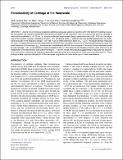Poroelasticity of Cartilage at the Nanoscale
Author(s)
Han, Lin; Li, Yang; Ortiz, Christine; Tavakoli Nia, Hadi; Grodzinsky, Alan J.
DownloadNia-2011-Poroelasticity of Ca.pdf (1.030Mb)
PUBLISHER_POLICY
Publisher Policy
Article is made available in accordance with the publisher's policy and may be subject to US copyright law. Please refer to the publisher's site for terms of use.
Terms of use
Metadata
Show full item recordAbstract
Atomic-force-microscopy-based oscillatory loading was used in conjunction with finite element modeling to quantify and predict the frequency-dependent mechanical properties of the superficial zone of young bovine articular cartilage at deformation amplitudes, δ, of ∼15 nm; i.e., at macromolecular length scales. Using a spherical probe tip (R ∼ 12.5 μm), the magnitude of the dynamic complex indentation modulus, |E*|, and phase angle, φ, between the force and tip displacement sinusoids, were measured in the frequency range f ∼ 0.2–130 Hz at an offset indentation depth of δ[subscript 0] ∼ 3 μm. The experimentally measured |E*| and φ corresponded well with that predicted by a fibril-reinforced poroelastic model over a three-decade frequency range. The peak frequency of phase angle, f[subscript peak], was observed to scale linearly with the inverse square of the contact distance between probe tip and cartilage, [1 over d[superscript 2]], as predicted by linear poroelasticity theory. The dynamic mechanical properties were observed to be independent of the deformation amplitude in the range δ = 7–50 nm. Hence, these results suggest that poroelasticity was the dominant mechanism underlying the frequency-dependent mechanical behavior observed at these nanoscale deformations. These findings enable ongoing investigations of the nanoscale progression of matrix pathology in tissue-level disease.
Date issued
2011-11Department
Massachusetts Institute of Technology. Center for Biomedical Engineering; Massachusetts Institute of Technology. Department of Biological Engineering; Massachusetts Institute of Technology. Department of Electrical Engineering and Computer Science; Massachusetts Institute of Technology. Department of Materials Science and Engineering; Massachusetts Institute of Technology. Department of Mechanical EngineeringJournal
Biophysical Journal
Publisher
Elsevier
Citation
Tavakoli Nia, Hadi, Lin Han, Yang Li, Christine Ortiz, and Alan Grodzinsky. “Poroelasticity of Cartilage at the Nanoscale.” Biophysical Journal 101, no. 9 (November 2011): 2304–2313. © 2011 Biophysical Society
Version: Final published version
ISSN
00063495
1542-0086